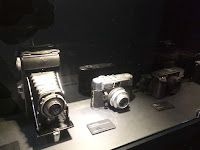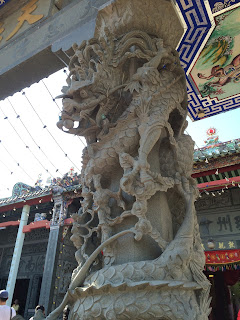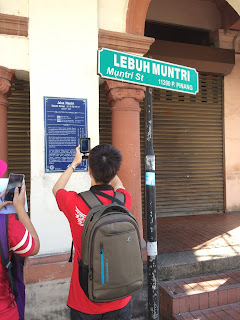My partner for this project is Hui Minh from New Media department. After we make some research and discover about Penang heritage in Georgetown area then we come out with idea to take bicycle as our subject or iconic. After a moment we found the only one person in penang whose rental those all of the bicycle to tourism and visitors. We can found that person who is the owner of bicycle rental at Padang Kota, close to the beach and the owner name is Laila .
George Town is the capital city of the Malaysian state of Penang, located on the north-east corner of the island. It had an estimated population of 500,000 as of 2010. The metropolitan area (which consists of Jelutong, Sungai Pinang, Sungai Nibong, Gelugor, Air Itam, Tanjung Bungah and Tanjung Tokong) has a population of 2.5 million, which makes it the second largest metropolitan area and the biggest northern metropolis in Malaysia. Excluding the metropolitan area, the area of George Town is the seventh largest city by population in Malaysia. Together with Alor Setar and Malacca City, it is one of the Malaysian oldest cities in the Straits of Malacca since its foundation by Francis Light, who was a captain and trader for the British East India Company (EIC) after being instructed by his company, Jourdain Sullivan and de Souza to establish presence in the Malay Archipelago.
Light gained control of Penang Island through a treaty negotiated with the Sultan of Kedah, although in the early stages of negotiation the Sultan refused to cede the island. The Fort Cornwallis was then established and he was successful in increasing the island import values and settlement population especially with the free trade policy the British used at the time. The Sultan of Kedah tried to regain control of the area when he saw the British had failed to provide protection to them as promised earlier in the treaty they had signed when the Sultan was attacked by the Siamese, the plan was however ended with a failure when Light implemented night raids on the Sultan's fortress. Prior to its successful trading post, many Chinese traders began to settle in the town as well to other areas in Penang Island to participate in agriculture and to manage plantations. This was continued under the administration of Straits Settlements with the migration of more Chinese together with Indian workers prior to the Industrial Revolution in Britain.
The situation during the World War I did not directly impact the town daily activities, although the Imperial German Cruiser Emdensank a French destroyer and a Russian cruiser before shelling the oil storage tanks near the city in the Battle of Penang. During World War II, however, the town suffered greatly, since as it was heavily bombed first by the Japanese and later by the Allies. After the war, the town remained as the capital of Penang until the formation of Malaysia in 1963. In 2008, it was listed together with Malacca City as one of Malaysian UNESCO World Heritage Site for its long history as a cosmopolitan city. Today, George Town is well known for its unique street foods, culture and heritage as well with its position as a medical tourism hub with many patients from neighbouring Sumatra in Indonesia frequently visiting the city to undergoing treatment.
The reason why we choose old bicycle for our icon is because old bicycle has many influence on penang heritage site such as Little Children on a Bicycle is a mural on the wall of a shophouse on Armenian Street, George Town. Ever since the mural was completed, it has drawn visitors in increasing numbers to stop over and take shots with them. People are coming up with creative poses.
Just take a look, so many people rent a bicycle to explore Georgetown Heritage Site
Half way of our journey, we decided to visit Masjid Kapitan Keling because this place is very popular in georgetown. Every tourist must visit this place if they were visiting Penang. Kapitan Keling Mosque is a Penang landmark. Built in 1801 by Penang’s first Indian Muslim settlers (East India Company troops), the Indo-Moorish structure is set at the junction of Lebuh Buckingham and Lebuh Pitt.
front door of Masjid Kapitan Keling
The tower of Masjid Kapitan Keling was
located in front of mosque.
When we walking through Lebuh Muntri we decide to enter the Camera Museum, Georgetown. The entrance fee doesn't too expensive and they give discount for student. The museum started its operation on 31 August 2013 and was officiated on 9 October 2013 by Penang Chief Minister Lim Guan Eng.
There is too much type of an old camera in the single space, its very intresting and some of our friend decide to make Camera Museum as their heritage icon.
Thean Hou temple was constructed between 1981 and 1987 at a cost of approximately 7 million Ringgit.
The installation dates of the Goddesses are as follows:
- 16 November 1985 - Tian Hou
- 19 October 1986 - Guan Yin
- 16 November 1986 - Shui Wei Sheng Niang
The temple was officially opened on 3 September 1989.
This artwork is below of the gateway, I'm very impressive with their painting , it just looks like modern ancient painting.
We continue walk for 5 minutes and then we do not even notice that we had gone through the Lebuh Muntri so fast. 75 Muntri Street was the home of famous 19th century Baba-Malay novelist Chan Kim Boon (1851-1920), who is better known by his pen name Batu Gantong. He earn his fame for translating Chinese classics into Baba Malay, a patois mixing market Malay with Hokkien, producing witty pieces that amused his local readership.
Sights along
Muntri Street
the signage of Fort Cornwallis
We decide to enter the Fort Cornwallis but at the last moment we have to cancel it because of the entrance fee.
Fort Cornwallis - named after the Governor-General in Bengal, Charles Cornwallis – is one of the most interesting historical landmarks in George Town, located close to the Esplanade, next to the Victoria Memorial Clock.
Entrance drawbridge of Fort Cornwallis
Fort Cornwallis map



























































